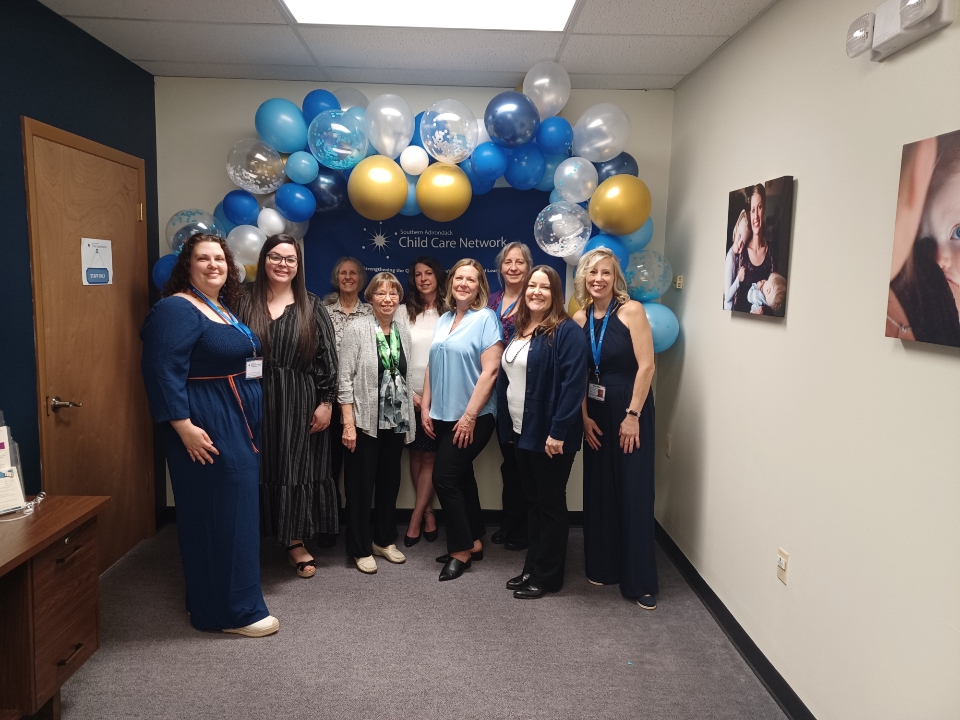
Courtesy of the Southern Adirondack Child Care Network
By Christine Graf
For more than three decades, Lynn Sickles has been serving the community as executive director of the Southern Adirondack Child Care Network (SACN). Established in 1992, the non-profit is one of 35 childcare resource centers in New York state.
Serving Warren, Washington, and Hamilton counties, SACN’s primary role is to help parents find child care.
“If a parent is looking for care, they call us and we put their information into a database that includes all of the regulated child care programs in Warren, Washington, and Hamilton counties,” said Sickles, noting that these services are offered free of charge.
The database generates a list of child care providers, ones that meet the specific criteria of each parent. After receiving the list, the parent must reach out to the providers to see if there are any openings.
“We also educate parents on what to look for when they go to visit a program,” said Sickles. “We then follow up with them to see if they were successful in their search. Finding child care remains the number one barrier for them—what many of them are telling us is that there were no openings.”
According to Sickles, the majority of child care in the tri-county area is family child care, regulated child care that takes place in a person’s residence.
“They don’t have big signs out front like child care centers do, so our service is really critical because it helps parents locate resources that they might not normally know about,” she said.
The nationwide child care crisis is being felt in Warren, Washington, and Hamilton Counties where there is a critical shortage of providers.
“Between 2019 and 2022, we lost 42 percent of child care slots in the area,” said Sickles. “It was related in part to the pandemic because people who were considering retiring opted to close their business. Others opted out at that point because they didn’t want outside families coming into their residence.”
Low wages also contributed to the decline in providers, and in New York the median salary of a child care worker is just $33,000 a year. Twelve percent of child care workers in the state earn below the federal poverty level.
SACN is working to address the crisis by providing free assistance to individuals interested in becoming licensed child care providers. In recent months, six new family childcare businesses were opened, one in Queensbury and five in Washington County.
“We provide technical assistance with the application and help them to get their program set up,” said Sickles. “We also provide start-up funding if they need it. That’s a key role that we play in helping people start child care business.”
Some of these funds have been made available through a $205,000 federal grant that was obtained by a bi-county task force comprised of representatives from SACN, Warren County Workforce Development, Saratoga County Workforce Development, and Brightside Up. Through this grant, residents of Warren and Saratoga counties may be eligible to receive funding to help defray the costs of opening registered home-based child care businesses.
With a staff of eight full-time and one part-time employee, SACN also provides professional development opportunities to child care workers.
“It might be helping them with curriculum development or setting up their environment. It could be related to health and safety, nutrition, business development, business practices, child development—we cover the gamut,” said Sickles.
SACN offers group trainings as well as one-on-one site visits, and staff members are available to answer questions via phone on weekdays from 9 a.m-4 p.m. All services offered by SACN are provided at no cost to the client, and the only fee that the agency charges is for its two-day professional conference held at Fort William Henry. This year’s conference takes place on November 15-16.
In addition to working with parents and child care providers, SACN assists employers, helping them to address the child care needs of their employees. As part of this work, SACN promotes the New York State Child Care Assistance Program. The program, one managed by local social services departments, provides eligible families with some or all of the cost of child care. To apply, parents must reach out to their local department of social services.
“As an example, a family of four could be earning $108,000 and receive child care assistance,” said Sickles. “Those rates have been going up over the past year, and that’s making more families eligible to get help paying for child care. But it’s hard right now because the child care supply is so small.”
According to Sickles, funds received through the program can also be used to pay legally exempt child care providers—providers who are not required by New York State law to be licensed or registered.
“They are not licensed by New York state, but they are enrolled. They are people who can care for one or two children, and the care is paid for by the Child Care Assistance Program. Often those people may be grandmothers or neighbors or friends, but they do have to be enrolled which includes a health and safety check.”
Locally, where the annual cost to send a child to a child care center is approximately $12,000 a year, Sickles said the Child Care Assistance Program will play a vital role in helping families afford child care.
“The annual cost of child care costs more than sending your child to a SUNY college (SUNY tuition is $7,070 per year). When you think about it that way, it shows why the Child Care Assistance Program is so critical,” she said.
